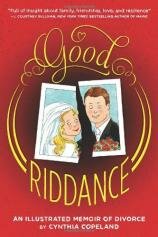The Long Goodbye: Cynthia Copeland on Good Riddance
What do you do when happily ever after ends? If you’re Cynthia Copeland and you’ve just caught your husband cheating, you pick up the pieces and move on…one step at a time. Copeland documented the years after her divorce in the funny and touching Good Riddance, out now, and here she discusses the book and the major life changes that inspired it.

Good Riddance
Congratulations on the book! It’s wonderfully funny and still serious at the same time. Was it difficult to maintain a storytelling balance in that sense --- to keep the sadness of these past events from overwhelming the good parts?
Thank you so much for your kind words!
I think that most break-ups inevitably involve an unexpected mix of humor and heartbreak, and my divorce was no exception (with its ironic twists and quirky side plots). So to some extent, achieving the right balance between the serious subject matter and lighthearted moments in Good Riddance was simply a matter of allowing the story to unfold naturally. When I sensed that the story was beginning to feel too light-hearted or too heavy at a given moment, I guided it in the other direction.
It’s easier to see the humor now that 12 years have gone by; the passage of time has muted much of the anguish I felt then and allowed the more playful moments to move to the front pages of my mental scrapbook. Now that my children are grown, and everyone is happy, healthy, and successful, it’s much easier to see certain events as funny rather than tragic.
Part of surviving divorce is moving past the negative energy to a positive place where you can focus on gratitude and good memories. Mine is a hopeful book, one that celebrates forgiveness and optimism rather than bitterness. I’d like readers to come away with the message that the scars we accumulate as we make our way in the world don’t prevent us from living full, gratifying, and genuinely happy lives.
Do you think you presented T.J., your ex-husband, fairly? I’m curious if he’s seen it and what your kids feel about it. They were very young when all this unfolded, but now that they’re older and can read and see what you’ve created here, do they have different perspectives?
I treated T.J. kindly. Our friends who know the whole story --- including “Sarah” and “Scott” --- reminded me that I left out some of the more sordid details about things that T.J. did. A few of my friends felt that I treated him better than he deserved to be treated. But we were married for 18 years, and I have wonderful memories of our time together --- I think that informed the way I wrote the story. I was aware that my children would read the book, and I didn’t want to include anything that would embarrass them, or affect their relationship with their dad. The things I left out were, for the most part, gratuitous tidbits that didn’t move the story forward and would have been hurtful to include; his unconventional, wacky personality was clear from the stories I did share. In addition, I had to keep the focus on my story and not let his take over. When I called to let him know that the book was coming out, I assured him that I didn’t include anything that wasn’t known within our circle of friends. He seemed fine with the idea of the book and I haven’t heard from him since it’s been released. He’s remarried (for the third time) so I don’t talk to him as much as I did when he was single. I don’t know if he’s read the book or not.
My daughters read the book and loved it. “Emma” now works in publishing, and she saw the book at a number of different stages. “Annie” lives in Portland, Oregon, and I sent her a copy: She thought it was fantastic. My son has read parts of it, and he really enjoyed what he read (and he loves that I named him “Jack,” which is the name he’d choose for himself today if he could!).
A page that made me laugh out loud and wince at the same time is the Family Tree of No Divorce page, where you discuss all the still-married (but dysfunctional) relationships in your family. Have any of those relatives seen that page? And is the no-divorce rate still intact for them?
So far, everyone is still married --- including all of the cousins, aunts, uncles, and other assorted relatives! My extended family loved the book --- my brother Gary is one of the book’s biggest fans! I wasn’t sure how he would react, but he just raves about it. My mom bought dozens of copies and mailed them to relatives and I’ve gotten lovely cards and emails in response.
A really interesting part of the book is Kate’s story of going through a similar case of infidelity but wanting to stick it out with her husband despite that. You mention in the book that there are no right or wrong decisions in these circumstances and that everyone must come to their own conclusions. Do you still feel that way? While going through this long nonfiction narrative, did you ever contemplate the fictional --- i.e., what might have happened if you hadn’t chosen to file for divorce?
When my story unfolded in real life, I heard from so many women who told me that they had dealt with infidelity and worked through it with their partners. Relationships go through good times and bad, and for some people, infidelity is a one-time mistake that leads to a renewed focus on the marriage. There is no one-size-fits-all response to infidelity. It is certainly challenging to rebuild a marriage when there has been a betrayal, but for some that is the best choice. Kate was insistent that I leave T.J. and fight for every penny I could get from him, and yet when the same thing happened to her, she was desperate to keep her husband and pleaded for him to stay. I was stunned by that!
The short answer to your question about whether I’ve ever thought about the road not taken --- what might have happened if I’d stuck it out --- is yes. It’s natural, I think, to go back and reexamine decisions made in the wake of infidelity because, at the time, you don’t even realize how shaken you are and how compromised your decision-making abilities are. When I realized that T.J. had been cheating on me, I just desperately wanted to feel as if I were moving forward, away from the heartbreak and toward something that might have a happy ending.
There is also the tendency to look back with the proverbial rose-colored glasses. As you move farther away from a relationship, you begin to question how bad it really was, and whether it could have been salvaged. But I came to the conclusion that even though I might have been able to force the marriage to limp along for a while, I believe that T.J. had moved on emotionally and had fallen out of love with me.
I tried to show in the flashback of our first meeting that T.J. and I didn’t have a lot in common: where I craved stability, T.J. loved taking risks, and as I tried to ground him, he tried harder to take flight. So it wasn’t a great match to begin with, but we tried for many years to find common ground and make it work.
Why did you want to tell this story as a graphic novel?
I must give credit to my agent, Dan Lazar at Writers House. He is the one who encouraged me to tell the story as a graphic novel. I’ve always been a doodler (“Cindy spends too much time turning her letters into little people,” my fourth-grade report card chided), and had illustrated other books, so it made sense to tell this story in both pictures and words. One compelling image can often convey a range of emotions and experiences that an entire paragraph of text just can’t. For instance, a panel from early in the memoir shows the view from above as I’m lying on my bed with my body appearing to slide off of the page head-first, creating the sense of disequilibrium and anxiety that I felt then but couldn’t have described as effectively with prose. I wanted the reader to feel as destabilized and almost visually discomfited while looking at the page as I felt when I realized that my husband was cheating on me.
As a storyteller, it’s freeing not to be limited by conventional prose. From a more practical standpoint, visuals allow characters to move easily from place to place or back and forward in time, which is useful in a story like mine that spans 25 years.
I tried to use the graphic novel format to draw in readers new to the genre. I wanted my pages to feel open and inviting, with loose illustrations and few severe borders. Many female readers are just discovering graphic novels, and I used a layout that appealed to me and that, I hope, appeals to other women --- especially those who are new to the genre or never imagined delving back into the world of illustrated books as adults!
Once I began working on the story as a graphic novel, I couldn’t imagine it being anything but.
How long did you spend working on it?
The book took three years total, from concept to finished art, and I was completely immersed in 18-hour days for the last six months. I created the book entirely by hand rather than on the computer, and each finished page took nearly a day to draw. My husband literally fed and watered me in my office.
Was it easier to work through all these memories in a graphic novel format? Or more difficult, in the sense that you not only had to relive the memories, but also re-create them? Was the entire process cathartic?
It was cathartic, and so much more emotional to draw myself crying and to create --- and then look at --- the characters on my drawing table than it would have been to just type out the words. There were days when I was drawing some of the more emotional moments that I just cried right through the process --- and I’m generally a very upbeat person. But yes --- I feel like it’s truly behind me now.
Have the people discussed in the book seen it --- and commented on it?
I called TJ before the book came out to tell him about it. I told him that anyone who could identify him knew the story already. My parents, brothers, and friends in the book truly loved it, which was very important to me. “Sarah” and “Scott” loved it; I don’t know if “Kate” has read it. (And I’m hoping that she doesn’t recognize herself if she does!)
Would you like to do more graphic novels in the future?
I would love to do more graphic novels; I’m working on a graphic novel for young readers right now.
-- John Hogan








